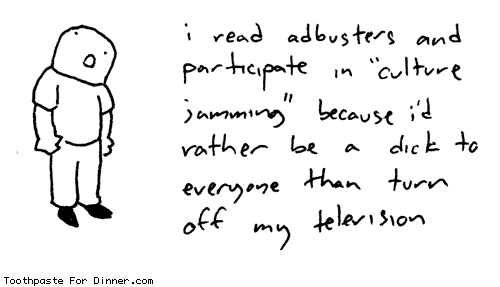 Where do we find advertisements? Do we find them on TV, billboards, in magazines? The true answer is they’re everywhere. Every step you take when walking outside is a step bombarded with images telling you to buy something. It seems like every message we get is concerned with what product we have to get next. It seems issues that really cause suffering, such as homelessness, poverty, and human rights violations are pushed away by this rush to consume. “Many public issues and social voices are pushed to the margins of society by market values and commercial communication, making it difficult to get the attention of those living in the "walled gardens" of consumerism.” (CCCE, 1). Culture jamming was created as a kind of a way to remedy this problem. Those who participate in culture jamming say that since society is saturated with branded images or icons, they will use these same branded images as vehicles for their social messages.
Where do we find advertisements? Do we find them on TV, billboards, in magazines? The true answer is they’re everywhere. Every step you take when walking outside is a step bombarded with images telling you to buy something. It seems like every message we get is concerned with what product we have to get next. It seems issues that really cause suffering, such as homelessness, poverty, and human rights violations are pushed away by this rush to consume. “Many public issues and social voices are pushed to the margins of society by market values and commercial communication, making it difficult to get the attention of those living in the "walled gardens" of consumerism.” (CCCE, 1). Culture jamming was created as a kind of a way to remedy this problem. Those who participate in culture jamming say that since society is saturated with branded images or icons, they will use these same branded images as vehicles for their social messages.Take the image above right for example.
Everyone is familiar with the logo for FedEx. It symbolizes a way to get packages quickly from one place to another. Anyone who sees this logo will automatically make this identification. One could argue that this logo constitutes a symbol which “are the images we use to represent concepts, ideas and philosophies.” (McCloud, 27) If that is the case, then what is the original FedEx logo really trying to represent? FedEx reinforces the consumer culture that culture jamming is trying to represent; it implies that what we need is lots and lots of stuff, and we need to get it fast. Culture jamming attempts to make this true ideology so transparent that someone viewing this image would question what FedEx is really about.
FedUp – With excess: a simple statement but it has much greater implications. Firstly it makes clear that FedEx is contributing to our culture of excess. No longer does great distance from the products we want to buy prevent us from buying them. FedEx allows us to buy anything from anywhere in the world, and get it quickly. “Many culture Jams are simply aimed at exposing questionable political assumptions behind commercial culture so that people can momentarily consider the branded environment in which they live. (CCCE, 1).” This is exactly what this culture jam will do. People who see it almost have no choice but to stop and think. They will ask themselves, what does this mean? Why is it written? Culture jamming requires people to actually think, and come to the realization that we live with excess everyday, and FedEx and other companies will contribute to its continuation unless we let it be known that we are fed up.
Culture jamming is one of the most effective ways to get the message out there on social issues. Sure, whoever is responsible for this culture jam could have written a page about how FedEx contributes to over consumption and how that is so. The problem with doing things in writing is that it doesn’t catch peoples’ attentions. People are more likely to pay attention and be affected by things that are visual, as opposed to written. “Pictures, to be sure, are more imperative than writing; they impose meaning at one stroke, without analyzing or diluting it.” (Barthes, 110) In using this familiar logo to get the message across it is even more effective. People already have context when it comes to the FedEx logo. There are already particular associations produced so that one viewing this message in the form of a culture jam would be more likely to understand it.
I leave you with this comic about culture jamming, which will hopefully remind you that viewing culture jams is only the first step. The next step must be doing something, even something small, to spread awareness about social issues. It is also important to remember that culture jamming isn’t about going against corporations, but about bringing to light their issues.

Works Cited
McCloud, Scott. Understanding Comics: The Invisible Art. 1st. New York, USA: HarperPerennial, 1994
Barthes, Roland. Mythologies . 1. New York: Hill and Wang, 1972.
"Culture Jamming and Meme Based Communication." Culture Jamming. Centre for Communication and Civic Engagement. 22 Nov 2008 http://depts.washington.edu/ccce/polcommcampaigns/CultureJamming.htm.
Images:
http://www.woostercollective.com/2007/06/07/fedupwith.jpg
http://www.toothpastefordinner.com/022407/culture-jamming.gif

1 comment:
First!
Post a Comment